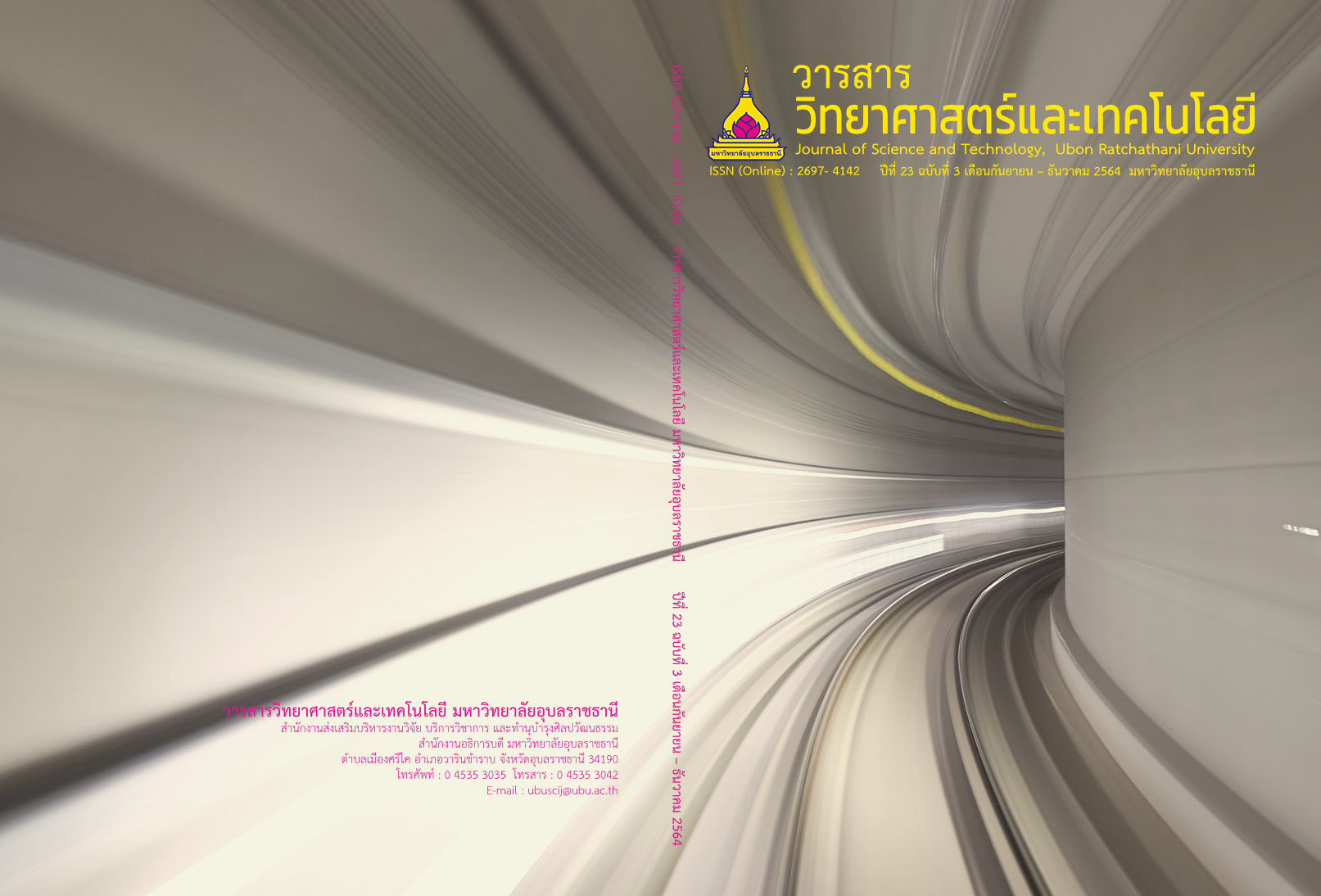การปลดปล่อยน้ำหอมจากไมโครแคปซูลในสภาวะจำลองการซักล้างและการอบแห้ง
Main Article Content
บทคัดย่อ
น้ำหอมในผลิตภัณฑ์ซักล้าง ซึ่งมักอยู่ในรูปของไมโครแคปซูลน้ำหอม เป็นปัจจัยสำคัญที่ส่งผลต่อการตัดสินใจเลือกซื้อ เนื่องจากเป็นสิ่งที่สร้างความพึงพอใจให้กับผู้ใช้ระหว่างการซักล้างและสวมใส่ งานวิจัยนี้ศึกษาปัจจัยต่าง ๆ ที่มีผลต่อการปลดปล่อยน้ำหอมจากไมโครแคปซูลน้ำหอมในสภาวะจำลองการซักล้าง และการอบแห้ง ซึ่งได้แก่ สมบัติของไมโครแคปซูล อุณหภูมิของน้ำซักล้าง (30-80 องศาเซลเซียส) ความกระด้างของน้ำ (50-350 มิลลิกรัมต่อลิตร) ค่าความเป็นกรดด่างของน้ำ (pH 2.1-10.7) และอุณหภูมิในการทำให้แห้ง (30-80 องศาเซลเซียส) จากการศึกษาไมโครแคปซูลด้วยกล้องจุลทรรศน์แบบใช้แสงและส่องกราด พบว่ามีลักษณะเป็นแบบแกนกลางเดียว ขนาดประมาณ 10 ไมครอน ผลการวิเคราะห์หมู่ฟังก์ชัน และความเสถียรทางความร้อนของไมโครแคปซูลโดยวิธี Fourier Transform Infrared Spectroscopy (FTIR) และวิธี Differential Scanning Calorimeter (DSC) ตามลำดับ พบว่าไมโครแคปซูลมีพอลิอะคริลาไมด์เป็นองค์ประกอบหลัก การวิเคราะห์การปลดปล่อยน้ำหอมจากไมโครแคปซูลภายหลังสภาวะซักล้างและทำให้แห้ง ด้วย Headspace Gas Chromatograph-Flame Ionization Detector พบว่า การซักล้างที่ 80 องศาเซลเซียสเป็นเวลา 1 ชั่วโมง ทำให้มีการปลดปล่อยน้ำหอมจากไมโครแคปซูลสูงถึงร้อยละ 16 ของน้ำหอมทั้งหมด ด้วยกลไกการปลดปล่อยแบบแตก ในขณะที่ การซักล้างที่อุณหภูมิ 30 องศาเซลเซียสเป็นเวลา 1 ชั่วโมง ทำให้มีการปลดปลดปล่อยน้ำหอมจากไมโครแคปซูลเพียงร้อยละ 4 ของน้ำหอมทั้งหมด ด้วยกลไกการปลดปล่อยอย่างต่อเนื่อง นอกจากนี้ความกระด้างของน้ำที่มีแคลเซียมคาร์บอเนตในช่วง 50-350 มิลลิกรัมต่อลิตร มีผลต่อการปลดปล่อยน้ำหอมจากไมโครแคปซูลอย่างชัดเจนเฉพาะการซักล้างที่อุณหภูมิ 60 องศาเซลเซียส โดยทำให้การปลดปล่อยน้ำหอมสูงขึ้น อย่างไรก็ตามความกระด้างของน้ำมีผลน้อยมาก และไม่มีผลต่อการปลดปล่อยน้ำหอมจากไมโครแคปซูล เมื่อซักล้างที่อุณหภูมิ 30 และ 80 องศาเซลเซียส ตามลำดับ การปลดปล่อยน้ำหอมจากไมโครแคปซูลค่อนข้างคงที่ในน้ำที่มีค่าความเป็นกรดด่างในช่วง 3.6-10.7 แต่จะสูงขึ้นเมื่อค่าความเป็นกรดด่างลดลงของน้ำเป็น 2.1 สำหรับสภาวะการทำให้แห้งที่ 30 องศาเซลเซียส น้ำหอมถูกปลดปล่อยออกจากไมโครแคปซูลอย่างช้าๆ ซึ่งการปลดปล่อยน้ำหอมนี้จะเพิ่มขึ้นตามอุณหภูมิการทำให้แห้งที่สูงขึ้น
Article Details
บทความที่ได้รับการตีพิมพ์เป็นลิขสิทธิ์ของ วารสารวิทยาศาสตร์และเทคโนโลยี มหาวิทยาลัยอุบลราชธานี
ข้อความที่ปรากฏในบทความแต่ละเรื่องในวารสารวิชาการเล่มนี้เป็นความคิดเห็นส่วนตัวของผู้เขียนแต่ละท่านไม่เกี่ยวข้องกับมหาวิทยาลัยอุบลราชธานี และคณาจารย์ท่านอื่นๆในมหาวิทยาลัยฯ แต่อย่างใด ความรับผิดชอบองค์ประกอบทั้งหมดของบทความแต่ละเรื่องเป็นของผู้เขียนแต่ละท่าน หากมีความผิดพลาดใดๆ ผู้เขียนแต่ละท่านจะรับผิดชอบบทความของตนเองแต่ผู้เดียว
เอกสารอ้างอิง
Galbraith C. 2018. An Overview of the Global Flavour & Fragrances Market, 11th edition. http://www.ialconsultants.com/uploads/CUBE_press_release/2018-08-02/FF_PressRelease_2018.pdf. Accessed 1 July 2021.
Zhang, Y., Song, J. and Chen, H. 2016. Preparation of polyacrylate/paraffin microcapsules and its application in prolonged release of fragrance. Journal of Applied Polymer Science. 133(42): 44136
Kaur, R. and et al. 2018. Potential use of polymers and their complexes as media for storage and delivery of fragrances. Journal of Controlled Release. 285: 81-95.
Perinelli, D. and et al. 2020. Encapsulation of flavours and fragrances into polymeric capsules and cyclodextrins inclusion complexes: an update. Molecules. 25(24): 5878.
Zhao, H. and et al. 2019. The fabrication of fragrance microcapsules and their sustained and broken release behavior. Materials. 12(3): 393.
Xiao, Z. and et al. 2019. Encapsulation and sustained release properties of watermelon flavor and its characteristic aroma compounds from γ-cyclodextrin inclusion complexes. Food Hydrocolloids. 97: 105202
Tekin, R., Bac, N. and Erdogmus, H. 2013. Microencapsulation of fragrance and natural volatile oils for application in cosmetics, and household cleaning products. Macromolecular Symposia. 333(1): 35-40.
Pena, B. and et al. 2012. Preparation and characterization of polysulfone microcapsules for fragrance release. Chemical Engineering Journal. 179: 394-403.
Bojana, B.P. and Marica, S. 2016. Microencapsulation technology and applications in added-value functional textiles. Physical Sciences Reviews. 1(1): 20150003.
Roberts, D.W. 2003. Optimisation of the linear alkyl benzene sulfonation process for surfactant manufacture. Organic Process Research & Development. 7(2): 172-184.
Ferreira, D. and et al. 2019. Quantification of the uncertainty of the visual detection of the end-point of a titration: Determination of total hardness in water. Microchemical Journal. 146: 856-863.
Gaabour, L. 2017. Spectroscopic and thermal analysis of polyacrylamide/chitosan (PAM/CS) blend loaded by gold nanoparticles. Results in Physics. 7: 2153-2158.
Radecki, M. and et al. 2015. Temperature-induced phase transition in hydrogels of interpenetrating networks of poly (N-isopropylacrylamide) and polyacrylamide. European Polymer Journal. 68: 68-79.
Ali, Z.A. and et al. 2011. Beneficial effect of chitosan-g-polyacrylamide copolymer in removal of heavy metals from industrial dye effluents. International Journal of Environmental Sciences. 1(5): 820-833.
Lopez-Leon, T. and et al. 2007. Hofmeister effects on poly(NIPAM) microgel particles: macroscopic evidence of ion adsorption and changes in water structure. ChemPhysChem. 8(1): 148-156.
Farooqi, Z. and et al. 2017. Stability of poly (N-isopropylacrylamide-co-acrylic acid) polymer microgels under various conditions of temperature, pH and salt concentration. Arabian Journal of Chemistry. 10(3): 329-335.
Yang, Z. and et al. 2014. Development and evaluation of novel flavour microcapsules containing vanilla oil using complex coacervation approach. Food Chemistry. 145: 272-277.


